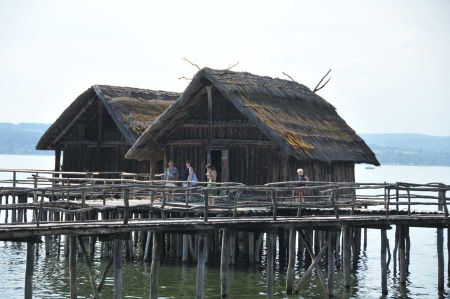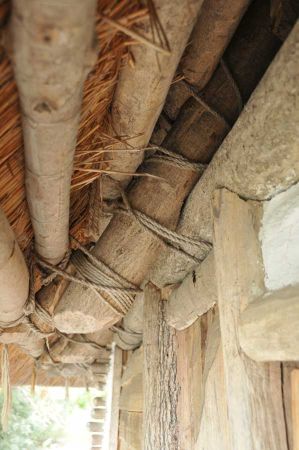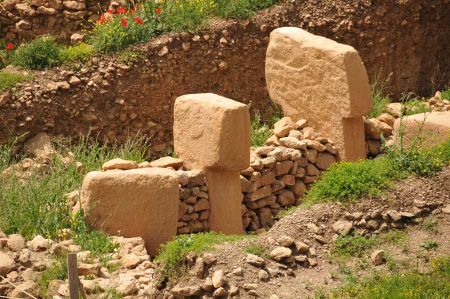In the history of human settlements, there have been a wide variety of structures in the creation of village communities, all of which have by no means been explored and thus known.
The transition from gatherers and hunters with constantly changing living conditions to settling farmers and cattle breeders took place in steps over many intermediate stages up to the first village of human coexistence. We have reported in detail on the oldest known settlement structures at Göbekli Tepe near Sanliurfa; to the urban planning masterpieces of ancient Roman cities. The creation of so-called tells was one of the intermediate steps on the way to village communities - and the associated development of infrastructure such as running water or sewage disposal.
Form of settlement Tell - a settlement mound
 The word tell or “tall” originally comes from the Arabic and describes an elevation in the landscape that was built by human hands through repeated and thereby renewing buildings on top of each other. Loosely translated, Tell means "hill" or better "settlement hill". When it comes to prehistoric settlement mounds, Turkish speaks of Höyük or Hüyük, in Persian of Tepe or Tappa, in Hebrew of Tel, in Greek of Magoula, in Romanian of Magura and in Macedonian of Toumba. This type of settlement was therefore widespread in the Neolithic. Tells are usually created in regions where clay was known to be used. For the most part, the tells consisted of air-dried or pounded mudbricks that were stacked in rows and smeared with mud to make the first buildings. Then washed out and caved in by rain over time, the following next generation building was simply built in the same place on top of the collapsed and then leveled building. This type of development can be found throughout the Middle East, in Greece, Bulgaria, Romania, Hungary and Serbia, but also in Denmark and Germany. A Neolithic settlement near Pietrele with the Tell Măgura Gorgana or in the city of Arbil (Arbela) with the citadel of Arbil, which is considered to be one of the largest tells found to date, has been identified. Albeit completely rebuilt. The same applies to the citadel of Aleppo in Syria (Fig. 1).
The word tell or “tall” originally comes from the Arabic and describes an elevation in the landscape that was built by human hands through repeated and thereby renewing buildings on top of each other. Loosely translated, Tell means "hill" or better "settlement hill". When it comes to prehistoric settlement mounds, Turkish speaks of Höyük or Hüyük, in Persian of Tepe or Tappa, in Hebrew of Tel, in Greek of Magoula, in Romanian of Magura and in Macedonian of Toumba. This type of settlement was therefore widespread in the Neolithic. Tells are usually created in regions where clay was known to be used. For the most part, the tells consisted of air-dried or pounded mudbricks that were stacked in rows and smeared with mud to make the first buildings. Then washed out and caved in by rain over time, the following next generation building was simply built in the same place on top of the collapsed and then leveled building. This type of development can be found throughout the Middle East, in Greece, Bulgaria, Romania, Hungary and Serbia, but also in Denmark and Germany. A Neolithic settlement near Pietrele with the Tell Măgura Gorgana or in the city of Arbil (Arbela) with the citadel of Arbil, which is considered to be one of the largest tells found to date, has been identified. Albeit completely rebuilt. The same applies to the citadel of Aleppo in Syria (Fig. 1).
The Tell Erbaba - an excavation example
 About 10 kilometers northwest of Beysehir there is also such a settlement hill, the Tell Erbaba, or as it is called in Turkish Höyük Erbaba. The Tell Erbaba was built around 5,500 BC or better 7,500 years ago in the Neolithic by people who settled here. The Tell Erbaba was discovered by the archaeologist R. Soleck, but excavation work under the direction of Jacques and Luisse Alpes Bordaz only began in the 1970s. The Tell Erbaba shows a diameter of approx.
About 10 kilometers northwest of Beysehir there is also such a settlement hill, the Tell Erbaba, or as it is called in Turkish Höyük Erbaba. The Tell Erbaba was built around 5,500 BC or better 7,500 years ago in the Neolithic by people who settled here. The Tell Erbaba was discovered by the archaeologist R. Soleck, but excavation work under the direction of Jacques and Luisse Alpes Bordaz only began in the 1970s. The Tell Erbaba shows a diameter of approx.
80 meters and consists of four epochs or floors built on top of each other, according to the excavation findings that have been uncovered so far. There were hardly any finds from the first epoch of the settlement, but rich finds from the third epoch. It is also interesting that blocks of stone were used to build the first, second and third floors. The walls are plastered with red mortar, the wall material is limestone bonded with mud mortar.
Today there are a large number of other settlement mounds in many parts of the Near East and Europe that are pending investigation or are already being excavated. More and more finds are also contributing to an ever clearer picture of the history of human development. Spreading this clarity and knowledge across the population can make a significant contribution to clearing up irritations and misinterpretations from so-called holy scriptures and thus help to avoid conflicts between cultures in the future, which, if you look back to the roots, are the same are of origin. It has always been the interests or ideologies of individuals that have led entire nations to ruin. And that hasn't changed to this day. Aleppo is now in Syria!
Please read as well:
Dalking Limes gate and watchtower in the Mahdholz
Ohrid - lovely city hike with Marta and Luis


